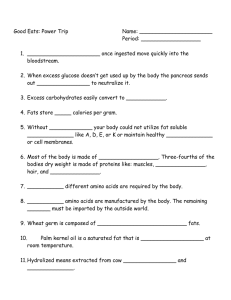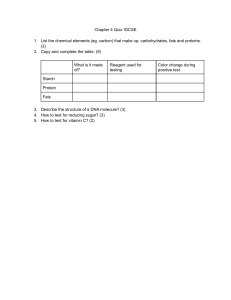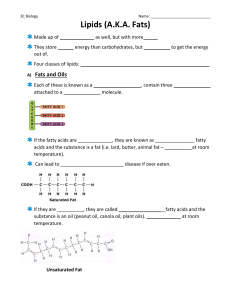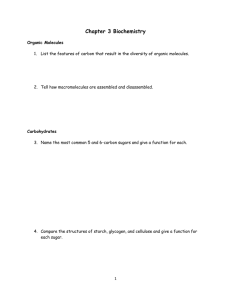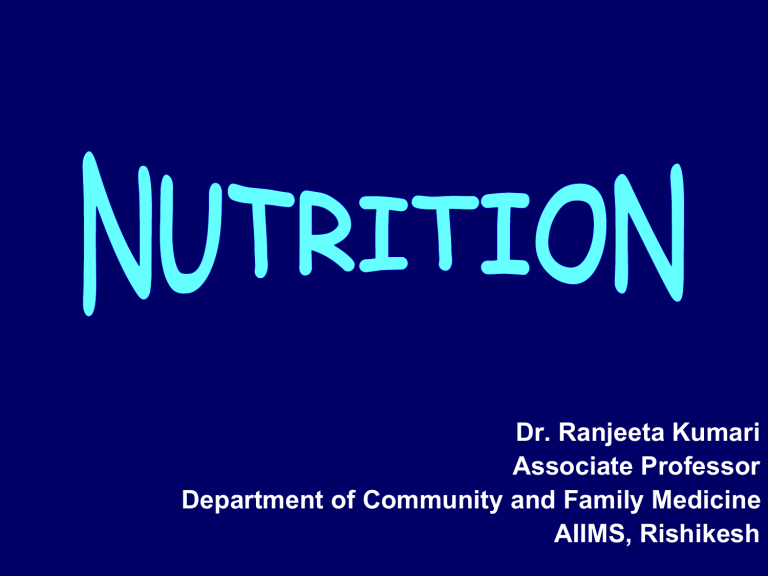
Dr. Ranjeeta Kumari Associate Professor Department of Community and Family Medicine AIIMS, Rishikesh Classification of food, macro and micro nutrients in diet, function of protein, carbohydrate, fat and their dietary sources INTRODUCTION Nutrition may be defined as “the science of food and its relationship to health”. It is concerned primarily with the part played by nutrients in body growth, development and maintenance. Good nutrition means “maintaining a nutritional status that enables us to grow well and enjoy good health.” Why Nutrition? Nutrition is an important component of the day to day lives of a person whether sick/ healthy. Food has an immediate effect (Satiety, Food poisoning, diarrheal diseases) as well as a long term effect (malnutrition, obesity, cancers etc.) on an individual’s health Nutrition is a modifiable risk factor for diseases at the level of an individual. The prescription for drugs is invariably followed by the advice about diet in a sick person specially in certain chronic diseases like hypertension, diabetes, obesity and metabolic syndrome etc. Why Nutrition? Epigenetics: Stream of science which deals with the effect of environmental and other factors on our genetic prototype. It proposes a control system of ‘switches’ that turn genes on or off, and suggest that nutrition, environment, toxins, our social environment, family bonds and stress- all have the ability to control these switches and cause heritable effects in humans. Why Nutrition? Nutrition is also very important during certain periods of life Infancy Till 5 years of age Adolescence Pregnancy and lactation Elderly INTRODUCTION contd… The word nutrient or “food factor” is used for specific dietary constituents such as proteins, vitamins and minerals. Dietetics is the practical application of the principles of nutrition; it includes the planning of meals for the well and the sick. CLASSIFICATION OF FOODS Classification by origin: - Foods of animal origin - Foods of vegetable origin Classification by chemical composition: Proteins Fats Carbohydrates Vitamins Minerals CLASSIFICATION contd… Classification By Predominant Function Body building foods: -meat, milk, poultry, fish, eggs, pulses etc Energy giving foods: -cereals, sugars, fats, oils etc. Protective foods: -vegetables, fruits, milk, etc CLASSIFICATION contd… Classification by nutritive value: Cereals and millets Pulses Vegetables Nuts and oilseeds Fruits Animal foods Fats and oils Sugar and jaggery Condiments and spices Miscellaneous foods CLASSIFICATION contd… Classification by food groups: 1.Cereals, millets and pulses 2.Vegetables and fruits 3.Milk and milk products, egg, meat and fish 4.Oils & fats and nuts & oilseeds Food Pyramid Extra Portions Pregnant women : Fat/Oil-2, Milk-2, Fruit-1, Green Leafy Vegetables-1/2. Lactating women : Cereals-1, Pulses-2, Fat/Oil-2, Milk-2, Fruit-1, Green Leafy Vegetables-1/2 Between 6-12 months of lactation, diet intake should be gradually brought back to normal. Elderly women : Fruit-1, reduce cereals and millets-2. NUTRIENTS Organic and inorganic complexes contained in food They are broadly divided into: Macronutrients: Proteins Fats Carbohydrates Micronutrients: Vitamins Minerals PROTEINS PROTEINS Proteins are complex organic nitrogenous compounds. They also contain nitrogen and sulfur and in some cases phosphorous and iron. Proteins are made of monomers called amino acids. There are about 20 different amino acids which are found in human body. PROTEINS Of these, 10 AA are termed “essential” as they are not synthesized in human body and must be obtained from dietary proteins. (AVHILL MPTT) Sources of Proteins Animal Sources: milk, meat, eggs, cheese, fish etc. These proteins contain all the essential amino acids . They have high biological value digestibility They are referred as “reference protein”. and Sources of Proteins contd… Vegetable Sources: pulses, cereals, beans, nuts, oil-seed cakes. These proteins are poor in essential amino acids. They have digestibility low biological value and They are cheap, easily available and consumed in bulk Supplementary action of Proteins Cereal proteins are deficient in lysine and threonine; methionine. pulses are deficient in Functions of Proteins Body building Repair and maintenance of body tissues Maintenance of osmotic pressure Synthesis of bioactive substances and other vital molecules- hemoglobin, enzymes, hormones, antibodies etc. Boost Immune mechanism Evaluation of proteins The parameters used are: Biological value (BV): absorbed/ intake Digestibility absorbed coefficient (DC): retained/ Protein efficiency ratio (PER) Net protein utilization (NPU): = BV Ⅹ DC / 100 Nitrogen retained by the body Ⅹ 100 Nitrogen intake Assessment of protein nutrition status Arm muscle circumference Serum albumin s/b > 3.5 g/dl 3.5 g/dl - mild malnutrition. < 3.0 g/dl - severe malnutrition. Serum transferrin Total body nitrogen Protein requirements 1 g/kg of body weight assuming a NPU of 65 FATS Fats Fats are solid at 20o C; oils are liquid. Classification: Simple lipids: triglycerides Compound lipids: phospholipids Derived lipids: cholesterol Fats yield fatty acids and glycerol on hydrolysis Essential fatty acids (EFA) are those that cannot be synthesized by humans: LA & ALA Sources of Fats Animal Fats: ghee, butter, milk, cheese, eggs and fat of meat and fish. Vegetable fats: from seeds e.g groundnut, mustard, sesame, coconut Other sources: Invisible fat Fatty acid content of different fats (in %) Fats SFA MUFA LA ALA High SFAs Coconut oil Butter/ Ghee High SFAs & MUFAs 92 68 6 29 2 2 - Palmolein 39 46 11 <0.5 High MUFAs & Mod. LA Groundnut oil Rice bran 19 17 41 43 32 38 <0.5 1 Sesame 16 41 42 <0.5 Fatty acid content of different fats (in %) Fats High LA Cotton seed oil Corn Safflower Sunflower High LA & ALA Soyabean Canola Mustard/ Rapeseed Flaxseed High TFAs Vanaspati SFA MUFA LA ALA 24 12 29 35 48 50 1 1 9 12 13 22 75 62 - 14 6 24 60 53 22 7 10 4 10 65 21 15 16 14 53 46 49 4 - Functions of fats They are high energy foods, providing as much as 9 kcal for every gram. Fats serve as vehicles for fat-soluble vitamins Fats in the body, support viscera such as heart, kidney and intestine Fat beneath the skin provides insulation against cold. The “non-calorie” roles of fat EFA are needed for growth, structural integrity of the cell membrane and decreased platelet adhesiveness. Cholesterol is an important component of membranes and is a precursor of steroid hormones and bile acids. The “non-calorie” roles of fat PUFA are precursors of prostaglandins- the local hormones responsible for : Vascular homeostasis Kidney functions Acid secretion in the stomach GI motility Lung physiology Reproduction. Hydrogenation Vanaspati Oils (Liquid) Hydrogenation Temp, Pressure, Unsaturated Catalyst FA (Semi solid & solid) Saturated FA EFA content ↓ Trans Fatty Acids Geometrical isomers of cis – unsaturated fatty acid Saturated fatty acids Obtained by partial hydrogenation Removes critical double bond in EFA Make the plasma lipid profile even more atherogenic than the saturated fatty acids ↓HDL, ↑LDL - Increases the risk of CHD Sources: Deep fried fast food, cake mixes, energy bars, chips, packaged cookies, pies and cakes. Refined oils Usually done by treatment with steam, alkali etc. Refining and deodorization of raw oils is done mainly to remove the free fatty acids and the rancid materials. It only improves the quality and taste of the oils. Choice of cooking oil Variety of oil instead of a single source Mix 2 or more oils with different composition (equal mixture of PUFA rich and MUFA rich oil supplemented with occasional use of mustard oil) Mustard oil contains erucic acid, which is bad for health therefore it should not be used as a sole cooking medium. Fats and disease Obesity: In fat people adipose tissue can increase upto 30% Phrenoderma: Deficiency of Essential fatty acids leads to rough and dry skin – “toad skin” Coronary heart Disease: High saturated fat Cancer: Colon cancer and breast cancer Others: skin lesions in Kwashiorkor Fat requirements In developed countries, dietary fats provide 30 to 40% of total energy intake. The WHO Expert committee on Prevention of CHD has recommended only 20 to 30% of total dietary energy to be provided by fats. At least 50% of fat intake should consist of vegetable oils rich in essential fatty acids. CARBOHYDRATE CARBOHYDRATE Main source of energy (4 Kcals/ gram) Carbohydrate is also essential for the oxidation of fats and for the synthesis of certain non-essential amino acids Sources of carbohydrates 3 main sources - starches, sugar and cellulose. The carbohydrate reserve (glycogen) of a human adult is about 500g. If the dietary carbohydrates do not meet the energy needs of the body, protein and glycerol from dietary and endogenous sources are used by the body to maintain glucose homeostasis. Dietary fibre Mainly non-starch polysaccharide. Found in vegetables, fruits and grains. Divided into Cellulose Non-cellulose polysaccharides (hemicellulose, pectin, storage polysaccharides like inulin, and the plant gums and mucilage.) Dietary fibre Can also be classified as Insoluble fibres: cellulose, hemi- cellulose and lignin. Soluble fibres: pectins, gums and mucilages Dietary fibre - Functions Absorbs water – increases bulk of stool – reduces constipation. By reducing intestinal transit time of food it drastically reduces the possibility of putrefaction and formation of gases and toxic substances. Inhibits faecal mutagen synthesis by changing colonic pH and bacterial metabolism. Dietary fibre - Functions Reduces the incidence of CHD – by binding to the bile salts and preventing its reabsorbtion and thus reducing cholesterol level in circulation. Gum and pectin reduce post prandial glucose level in the blood. Disadvantage – Too much of fibre can decrease the absorption of valuable micronutrients. Dietary fibre - Requirements 40 gms of dietary fibre per day. Indian diet provides 50 – 100 gms/ day Total fibre g/100g High (>10) Wheat Jowar Medium (1-10) Rice Bajra Most vegetables Ragi Most Fruits Maize Coconut Legumes Sesame Fenugreek Almonds Dals Dates Low (<1) Nil Refined and Sugars processed Fats/ oils foods Milk All types of meat
